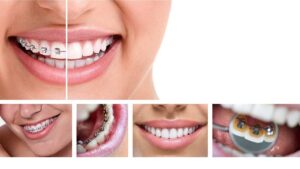A healthy dental system ensures a healthy life full of happiness. Besides functional perfection, an aesthetically pleasing dental system gives you the confidence to smile freely. Unfortunately, not everyone is born with perfectly aligned teeth, affecting the functional efficacy of the oral system and making them self-conscious of their facial appearance. Thanks to the technological advancements made in orthodontics, now you have several types of braces to move your misaligned, crowded, or crooked teeth in the right position to make your teeth functionally perfect and aesthetically brilliant. All types of braces are equally great to achieve desired teeth shifting goals, but your orthodontist will recommend the best that suits your specific need. Although best results could be expected during adulthood, it is never too late to make your dental system better and pleasing. The outcome varies, but you can get quality results by following braces treatment guidelines. Braces treatment takes 6 to 24 months involving multiple progressive adjustments to bring misaligned teeth in the right position, so the braces treatment costs are usually high. However, you can reduce braces cost significantly.
Continue reading to know all about braces treatment, how it works, type of braces and cost, and ways to cut treatment cost.
Do I Need Braces to Make Smiles Better?
Millions of people are enjoying the benefits of braces treatment with brilliant smiles. It is an endorsement of the fact that the braces are highly effective in making your teeth functionally better and aesthetically more pleasing. However, it doesn’t mean it is equally great for everyone and all possible issues related to dental structure. Your orthodontist will examine your dental structure in detail and recommend suitable orthodontic treatments including braces. Braces are usually recommended to correct dental anomalies like:
- Teeth overcrowding or crooked teeth
- Teeth spacing issues
- Teeth misalignment
- Jaw misalignment related issues like overbite, underbite, and overjet
- Smile improvisation
What are Braces and How do Braces work?
In simple words, braces are devices designed to move teeth in the desired direction biomechanically as per the treatment plan. Following a thorough examination of your dental structure, your orthodontist will suggest braces treatment to correct overcrowding, crooked, or misaligned teeth, and related dental issues. The selection of the type of braces to straighten your teeth depends on the severity of the case, age, your expectations, and of course the budget. If your lifestyle and work don’t permit wearing a little bolder traditional metallic braces, you can ask your orthodontist for something discreet such as Invisalign clear aligners.
Before you start wearing braces to make your teeth and smile straight, you need to understand how braces work. Understanding the process is very important as it will help you follow instructions religiously and achieve desired results in the minimum possible time without much discomfort.
The membrane underneath the gum controls the position of teeth on the jawbone. So, biomechanical pressure created by braces comprising wires, brackets, and ligatures, moves teeth in the desired direction over a period of time. Depending on the complexity involved and the type of braces you wear, you have to visit the dental clinic at stipulated intervals for adjustments and changing aligners, or course correction. Progressive adjustments or changing aligner sets start moving teeth and reshaping the dental structure, and by the end of the treatment period, you will have better-looking perfectly aligned teeth.
What Are the Components of Braces?
The dental structure is highly complex and requires meticulous treatment planning and execution to move teeth using braces of your choice and suitability. Braces treatment is costly as these are made of multiple things and require progressing intervention to achieve realistic teeth straightening goals. Braces are made of:
- Brackets
Your orthodontist will first clean the surface of your teeth and make it plaque and tartar free and then fix brackets on teeth using suitable adhesive to hold wire and apply even pressure. Besides traditional stainless steel brackets, now you have more discreet options of plastic and ceramic brackets. The procedure might be a little uncomfortable, but it isn’t painful. Mostly these are placed in front of the teeth surface, but if you are looking for discreteness your dentist could place them at the back of your teeth.
- Bands
Once brackets are properly applied on the teeth surface, the orthodontist will place elastic bands, also called O-rings or ligatures, around the brackets. Depending on your preference you can choose band material and color, and let wires create subtle pressure to move teeth as per the treatment plan.
- Spacers
If there is a space constraint at the back of your mouth making it difficult to fit braces properly, your orthodontist might place spacers between molars to create the required space. Spacers are not required in all cases of teeth straightening, but for better results, your dentist could recommend using spacers to push the jaw forward by creating space at the back of your mouth.
- Archwires
Archwires are a most important component of the braces as it is responsible for creating biomechanical pressure to move teeth in the desired direction. Archwires, made of stainless steel, titanium, or alloy, connect brackets and create even subtle pressure during the treatment.
- Springs
If the treatment requires space created between two of your teeth, the orthodontist could place coil springs on the archwire. It helps in moving teeth apart and creating space to straighten misaligned teeth.
- Facebow Headgear
If teeth straightening require applying extra pressure on your teeth, your orthodontist might recommend wearing facebow headgear at night. It is rarely used these days, so discuss alternative options if you think it is going to affect your normal life.
Type, Function, and Braces Cost
Correcting structural anomalies of the dental system is important for both functional and aesthetic purposes. Braces are proven to be one of the most effective treatments to straighten teeth. If the metal mouth makes you self-conscious of your appearance, you can opt for discreet alternatives that suit your need and purpose. Braces are unquestionably a great treatment to move teeth in the right position, but the outcome depends on the suitability of a particular type of braces. Whether you want your corrective appliance to be fixed or removable, metallic or clear plastic-type, discreet or something more colorful and vibrant just let your orthodontist know about your preference and he will recommend the best that will help you get straight teeth and smile. Here are the types of braces options available to correct your misaligned teeth and related complexities:
- Traditional Metal Braces
It is one of the most popular braces used across the world to correct structural anomalies as these are effective in correcting even the most complex misalignments at far less cost. Orthodontists attach brackets and bands in front of teeth with dental adhesive as holders of the flexible wire or archwires. In some cases, rubber bands or metal ties could be attached to connect brackets to the wires to create extra pressure to move teeth in the desired direction. If required, you may be asked to wear headgear at night to bring highly crooked teeth in alignment by creating additional pressure.
Metallic Braces Cost: It cost an average of $3,000 to $6,000, however it could be a little less or more depending on the complexity involved, experience and reputation of the orthodontist, dental insurance, and of course the location of the dental clinic.
- Ceramic Braces
Unlike metallic braces, which make some people a little more conscious, the tooth-colored ceramic material is used in making brackets. It gives you the much-needed discreteness and confidence to smile freely.
Ceramic Braces Cost: Unlike metallic braces, ceramic braces cost a little more in the range of $4000 to $8000. Besides, the cost could rise if you opt for metals like gold or titanium.
- Lingual Braces
If the visibility of wires and brackets is a matter of concern for you, you can opt for lingual braces. Unlike traditional braces, the brackets of lingual braces are fixed on the backs of your teeth, so no one will notice you wearing braces.
Lingual Braces Cost: Placing brackets of lingual braces on the back of teeth is a little complex. So, if you want to straighten your teeth using lingual braces, you have to spend anything between $8000 and $10,000.
- Clear Aligners
If you are super conscious of your appearance during the brace treatment, you can opt for invisible braces. Custom made of high-quality transparent plastic material, clear aligners fit perfectly on your teeth and do teeth straightening tasks discreetly. It comprises a set of aligners, which you have to change every two weeks to straighten your smile in a few months. Most importantly, clear aligners like Invisalign give you the much-needed flexibility to remove them for routine oral hygiene. But, you have to wear aligners for at least 22 hours daily to get a better result in the minimum possible time.
Clear Aligner Cost: The cost of clear aligners varies depending on the number of sets required to achieve desired teeth straightening results. If you opt for Invisalign, it might cost you anything between $3000 and $8000, depending on the complexity involved.
Key Takeaways
You can make your smile better with braces, but cosmetic improvisation procedures, including orthodontic procedures, are expensive. It is better to consult a qualified orthodontist to get your dental system examined so that he could recommend the most suitable braces type. Insurance companies usually cover part or pay full, only if it affects your child’s eating, swallowing, or speech functions. Thankfully, dental clinics offer attractive interest-free part payment plans to help you get the best possible teeth straightening treatments. You can cut treatment costs by getting some aid from financial aid programs and Medicaid. Treatment cost varies significantly from place to place, so do your research and negotiate the best deal without sacrificing the quality.
Sources:
- Wong, B. H. (2002). “Invisalign a to z”.
https://www.sciencedirect.com/science/article/pii/S0889540602539561 - Wiechmann, D. (1999). “Lingual orthodontics (part 1): laboratory procedure”.
https://link.springer.com/content/pdf/10.1007/BF01301249.pdf - Priyanka, S., Felicita, A. S., & Leelavathi, L. (2018). “Complications of ceramic brackets”.
http://search.ebscohost.com/login.aspx?direct=true&profile=ehost&scope=site&authtype=crawler&jrnl=09757619&AN=133549333&h=MhBVIhw9g3eGW0wMAStw1VV8YGRk5Cv2J0ry4KpjTxFJcmSLEMOOVNO9tgKyv0IdLUwCVKGLXvh3L8N0sYGQDw%3D%3D&crl=c - Azaripour, A., Weusmann, J., Mahmoodi, B., Peppas, D., Gerhold-Ay, A., Van Noorden, C. J. F., & Willershausen, B. (2015). “Braces versus Invisalign®: gingival parameters and patients’ satisfaction during treatment: a cross-sectional study”.
https://bmcoralhealth.biomedcentral.com/articles/10.1186/s12903-015-0060-4



